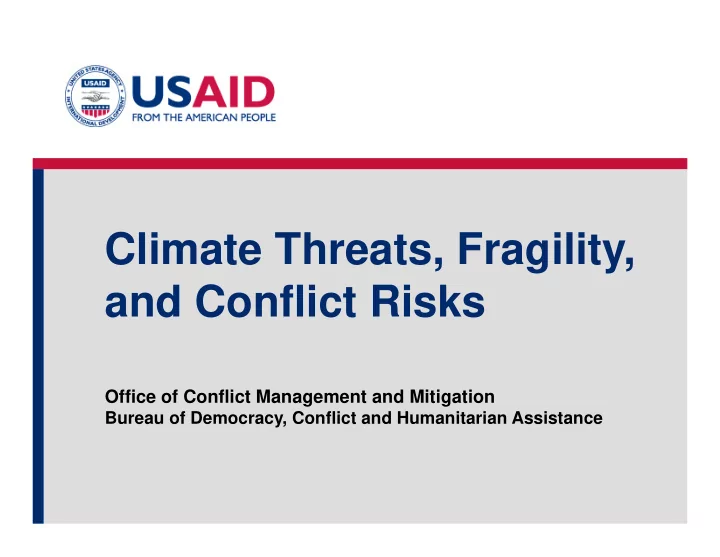

Climate Threats, Fragility, and Conflict Risks Office of Conflict Management and Mitigation Bureau of Democracy, Conflict and Humanitarian Assistance
Global Conflict Countries with active 25 armed conflict Countries where conflicts 13 ended 1 to 5 years ago Countries where conflicts 12 ended 6 to 10 years ago 50 Conflict ‐ affected countries
Conflict and Fragility 50 Conflict ‐ affected countries 24 experience high levels of fragility additional countries have fragility levels above 15 the global average Conflict ‐ affected countries (78%) have above ‐ 39 average fragility levels
How do the set of countries that are most threatened for heightened climate risks relate to the set of fragile or conflict ‐ affected states?
Climate Threats Methodology USAID 2011 Alert List – Overlay of fragility and future climate vulnerability Climate vulnerability estimate Adapted from David Wheeler, Center for Global Development Examines global weather data and projects them forward using econometric modeling techniques Uses the model to obtain individual risk scores for all countries globally Exclusive focus on the physical vulnerability to climate hazards without weighting for societal capacity to cope and adapt
Vulnerability to Climate Threats
Climate Vulnerability and Fragility
Climate Vulnerability and Fragility High Climate Vulnerability High Fragility
Climate Vulnerability and Fragility High Climate Vulnerability Conflict Mitigating Factors High • Legitimate governing institutions Fragility • Resilient economic and social institutions (high levels of social capital or cohesion) • Higher levels of human security
Climate Change as Cause for Conflict: Implications Countries with high fragility The risks of conflict are already very high due to many other factors The consequences of climate change join those factors Countries with low fragility Existing macro-level attributes of state and society suggest potential for mitigating any conflict risks that climate threats may cause Programming Implications In fragile and non-fragile states, programming to address climate threats should be sensitive to its impact on pre- existing conditions (existing mitigators or vulnerabilities) that relate to violent conflict
Concluding Comments A change in the ‘framing discussion’ about climate and conflict Sub ‐ national dynamics are critical Understanding the micro ‐ level story
Supplemental Slides
Fragility Indicators
Climate Vulnerability and Instability Most states that are highly fragile or at high risk for instability are also vulnerable to climate related threats. High Fragility The converse, however, is not true These findings remain preliminary. Research is ongoing. High Climate Vulnerability
Recommend
More recommend